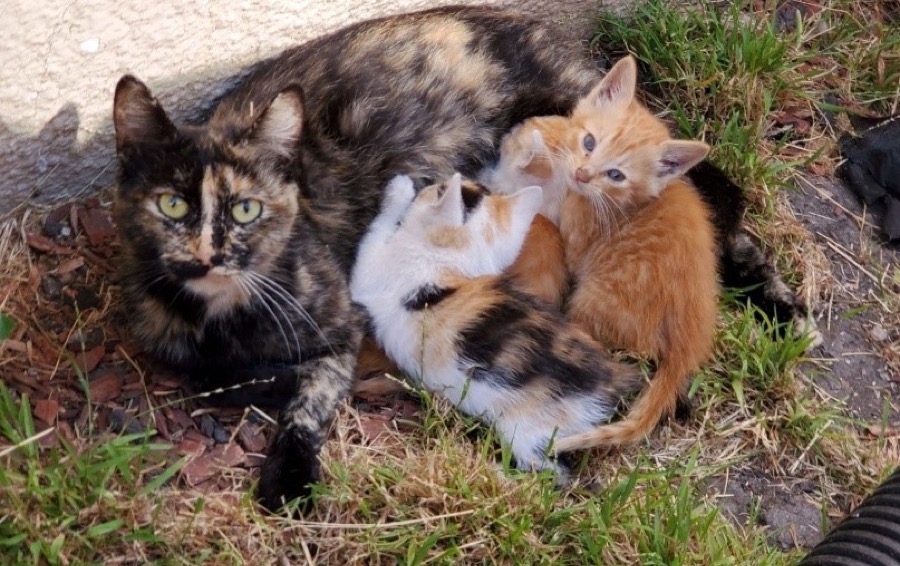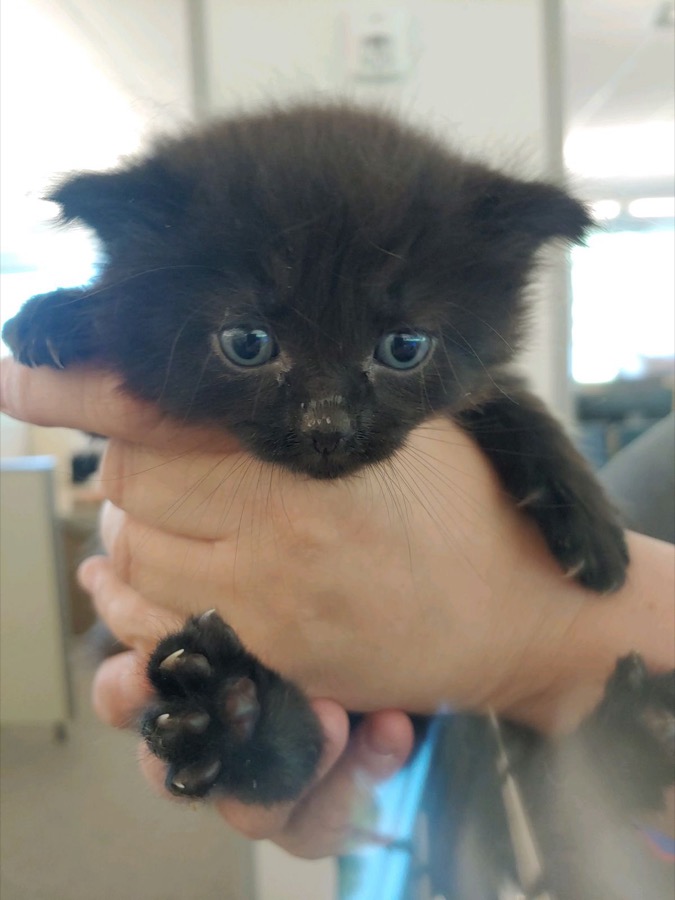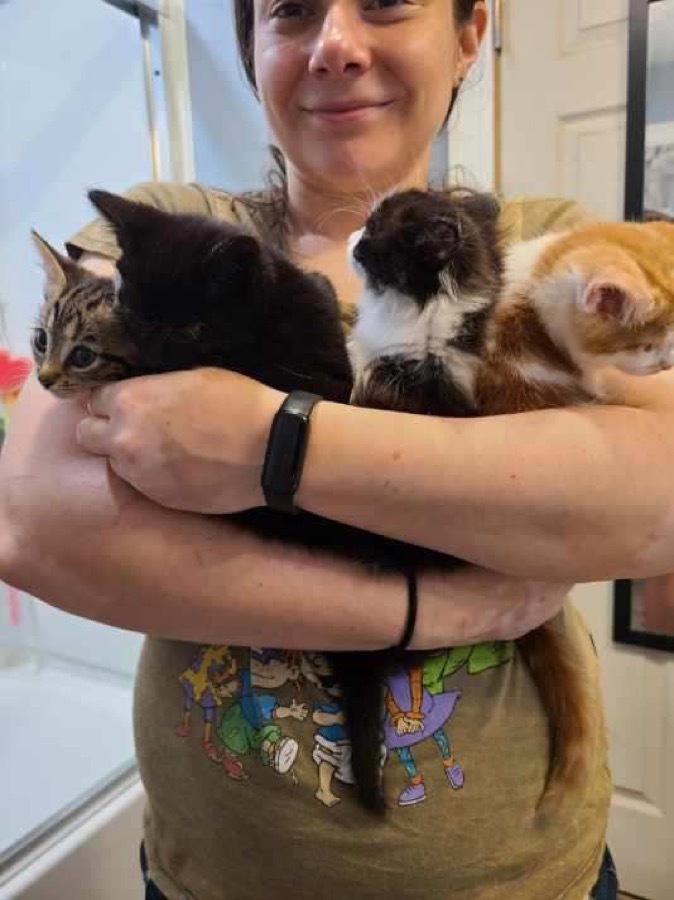Colony Management – Socializing Feral Kittens
FERAL CATS ARE NOT SOCIALIZED TO PEOPLE AND CAN’T BE ADOPTED
The decision to bring feral kittens into your home should not be taken lightly. Socializing and caring for feral kittens is a time-consuming process which requires devotion, patience, and attention.
Kittens that do not have any contact with humans after they are born will be feral, regardless of whether their mother is a lost house cat or a feral cat living in a colony. They will be frightened of people and demonstrate all of the signs of fear and anxiety that an adult cat would, like spitting, hissing, and running from human contact.

Sadly, people often bring feral kittens into their home and then do not take the time to work with them. Weeks, or months, later, they realize that they cannot touch the cat— they have feral cats in their home that cannot be adopted.
To become pets, feral kittens need to be socialized, or taught to be comfortable around people. If the kittens are eight weeks or younger, usually just about anyone can socialize them by following some simple steps. Kittens older than two months (eight weeks) of age often take more time and skill to socialize.
With some time and attention you can work with young feral kittens to help them become affectionate and loving companions. It’s not a transformation that happens overnight—socializing kittens is a big commitment. If you don’t feel you have the time or the network to socialize the kittens, or if they are older than four months, it is better for you and the kitten for her to be returned to the colony after neutering.
Feral Cat FOCUS does not recommend attempting to socialize adult feral cats or kittens older than three months of age.
BEFORE YOU MOVE FORWARD CONSIDER
1. Time: Do you have the time it takes to socialize kittens? You will have to commit to caring for them one-on-one for at least a couple of hours each day, for a period of a few weeks to a month or longer. If the kittens are neonatal, they will require even more specialized care, including round-the clock bottle-feeding. Make sure you know ahead of time what a project like this will require from you: time, love, patience and endurance!
2. Adoption Expertise and Connections: After socializing the kittens, they will need adoptive homes. Do you have the network—friends, acquaintances, organizations— to help you find those homes? Finding and screening homes for kittens takes work. Consider the paperwork required—adoption fees, forms, and contracts—as well as your ability to get the kittens neutered before adoption when deciding whether to socialize them or not.
3. Feral Cat FOCUS recommends early-age spay/neuter. A kitten can be spayed/neutered at approximately three months old as long as it weighs 2.5 pounds (3 pounds is preferable).
4. Kitten Age: If kittens are trapped at two-three months of age (8-10 weeks) they can be spayed or neutered and returned to their colony. If you do not have the time to devote to socializing kittens, please keep them with their colony. These kittens should be neutered, vaccinated, and returned to their outdoor home.
HOW TO CARE FOR NEONATAL KITTENS

Here are some important tips to keep in mind if you do end up having to care for a neonatal kitten (1-4 weeks old). Be aware that sometimes, no matter what you do, some neonatal kittens do not survive and can fade very fast. You can only try to be the best surrogate guardian possible, and hope for the best.
SOCIALZING FERAL KITTENS
Feral cats are not socialized to people—and can’t be adopted. With some time and attention, however, you can work with young feral kittens to help them become affectionate and loving companions. It’s not a transformation that happens overnight—socializing kittens is a big commitment—but it’s a very rewarding experience.


TAMING FERAL KITTENS
We often receive calls from people who have a feral cat who just had kittens. First and foremost, the female cat must be spayed. Then there are two options for the kittens depending on age: 1) spay or neuter and return to their original environment or 2) socialize to the point where they are friendly enough to be adopted into good homes. Clearly the latter is the better choice, but it will take some work on your part.
For health and nutrition reasons, you should wait until the kittens are at least 4-5 weeks of age before taking them away from their mother. Kittens who are 5-8 weeks old will take approximately two to four weeks to be socialized. Kittens who are 10-12 weeks old may take longer. Taming kittens over 12 weeks can be difficult, but each kitten is unique.
GETTING STARTED
• Kittens must be brought inside and confined in a cage with litter, food, and bedding. May need trapping.
• Kittens should be separated into different cages so taming can be effective for each one.
• Do not let feral kittens run loose in your home. They can hide in tiny spaces.
CONTAINMENT I — IN CAGES
• Contain kittens in cages. For first two days, do not attempt to handle. They need to feel safe. Visit them, talk to them, sing to them. Move gently around them. Keep cages covered so darkness will calm them.
• After two days, place small towel over kitten, leaving head free. Pet kitten’s head gently, only from behind. If kitten remains calm, grasp it by the nape of the neck. Put towel in your lap and place kitten on towel. Talk to kitten softly and stroke gently. You can use one-finger stroking at first, then whole-hand stroking. Do this briefly for each kitten. Then put it back in the cage and give it a treat.
• Repeat this process several times a day, preferably at the same time each day so kitten comes to expect it.
• Do not stare at kitten. Lower your head in a submissive, non-threatening pose.
• You can introduce play at this point with appropriate cat toys. Do not leave toys in cage. Do not let kitten scratch you.
• You can move cages to different parts of the house to help kittens get used to various noises.
CONTAINMENT II — IN A SMALL ROOM
• Progress will depend on kitten’s age and temperament. Possibly in one week, when kitten is comfortable with your touch, you can let it out into a small room.
• Room should be self-contained and “kitten-proofed”. Don’t let kittens go under beds or into closets.
• Continue socializing behavior in small room. Encourage kitten to come to you for food, touching, play.
• After several days or a week, allow other people to handle and play with them. Kittens tend to bond to one person initially but they need to be socialized to people in general.
PLACEMENT
• When kitten no longer hisses or runs away from people, you can begin the process of finding a good home. But kitten should be spay/neutered first with special attention paid to recovery.
• A good indication of completed socialization is when you can “pass the kitten” to several people and the kitten does not have its tail between the legs (a sign of fear).
• Notify prospective owners that kitten was once feral and needs lots of love. And congrats to you for a job well done!
• Adoption Agencies
Please take necessary precautions to avoid being bitten/scratched by kitten. Rabies can be transmitted to humans when an AFFECTED kitten bites or scratches a human. Rabies is fatal to humans, unless a series of post-exposure shots is received soon after exposure. If you are bitten/scratched by an animal, seek immediate medical attention and report incident to your county’s health department.
